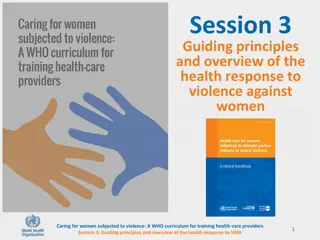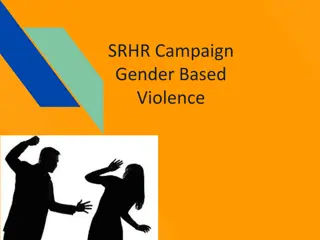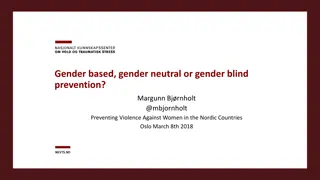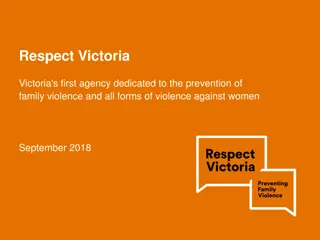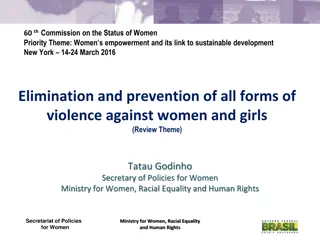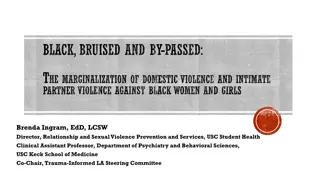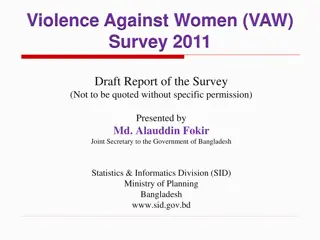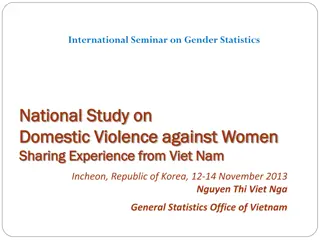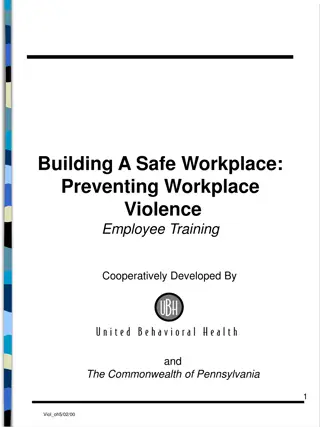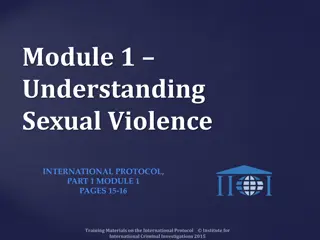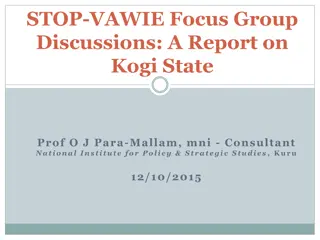Violence Against Women is a Workplace Issue
This presentation emphasizes the significance of addressing violence against women in the workplace. Employers will gain insights on creating a safe and supportive environment for all employees.
Download Presentation

Please find below an Image/Link to download the presentation.
The content on the website is provided AS IS for your information and personal use only. It may not be sold, licensed, or shared on other websites without obtaining consent from the author.If you encounter any issues during the download, it is possible that the publisher has removed the file from their server.
You are allowed to download the files provided on this website for personal or commercial use, subject to the condition that they are used lawfully. All files are the property of their respective owners.
The content on the website is provided AS IS for your information and personal use only. It may not be sold, licensed, or shared on other websites without obtaining consent from the author.
E N D
Presentation Transcript
Violence Against Women is a Workplace Issue A presentation for employers
Domestic or Family Violence is..... Domestic or family violence is an abuse of power by a partner or ex-partner or family member. It takes many forms including intimidation, control, isolation and emotional, physical, sexual, financial or spiritual abuse. Domestic violence can also occur between people in an intimate relationship who do not live together, between people in same-sex relationships , between carers and the person in their care and between people in kinship relationships. Domestic violence tends to increase over time, becoming more serious and more frequent. Domestic violence harms both the victim, and others including children, who witness the abuse. Both men and women can experience domestic violence, but women experience more severe and persistent forms of abuse and are more vulnerable due to often having the primary care of children
Violence against women is an issue for employers At least 1 in 10 women in the workplace are current victims of domestic violence. Victims (as well as perpetrators) create direct costs to employers because their unpredicted absences and other behaviours reduce their own productivity and often also contribute to reducing the productivity of their workmates. The perpetrator may make it hard for a victim to get to work or target the victim at work The most common form of domestic violence experienced at work is abusive calls and emails The strain of dealing with domestic violence can undermine a worker s productivity, performance, and well-being Victims are particularly vulnerable in the workplace. This is due to the predictability of their location or working hours or both
Cont..... Domestic violence can also create problems for other staff and managers, who may be targeted as well, posing workplace safety and, ultimately, liability issues In extreme cases, victims have been stalked and eventually killed by violent ex-partners whilst in the workplace Employees who a victims of family violence may be: distressed, anxious, distracted and fearful at work Struggling to manage their workload Forced to leave their job so they can hide from the perpetrator Prevented from getting to work on time or at all Absent a lot Phoned or emailed constantly by the perpetrator
Domestic Violence Impacts on Workplace Productivity There is an average of 130 lost working hours for each employee who is a victim. This includes: 17,493 days of work lost due to victims leaving work early or arriving late to work; and 950,725 days of work lost due to termination of employment; and 1,286,473 days of work lost due to victims being distracted at work. 26,724 days will be lost due to physical abuse and 8143 days lost due to sexual abuse. 1410 days of work lost because of stalking.
In any year..... Over 111,000 women in the workforce (7% of all New Zealand women) will be experiencing domestic violence Because of the absence of effective workplace protections for victims, domestic violence will have cost employers at least $368 million annually. If nothing is done, there will be a loss of 2.3 million days of work in the 10 years until 2024 Of this, over half, almost 1.3 million days of productive work time, will be lost due to victims being distracted at work by harassment and fears about their safety and that of other family members Over and above that, there will be days of productive work lost because of the consequences of physical abuse, sexual abuse and stalking as well as losses to employers through job termination costs such as recruitment and re-training
Domestic violence affects all staff Nearly half those who had recently experienced an incident of domestic violence had discussed the violence with someone at work. Colleagues of people experiencing violence at home may: feel resentful because they are carrying the workload for people who are away a lot may be aware of the abuse their colleague is experiencing and appear unsupportive be worried about safety for their colleague/friend and themselves Employees who are perpetrators of violence may: pose a risk to the victims colleagues pose a risk to workers and clients in their own workplace use work time and resources to harass, stalk and monitor their victim need to take time off to attend court or stopping violence programmes
Employees May Not Ask for Help Lots of things can stop people from asking for help when they re in violent situations. These include: their own experiences and perceptions resources available to them how others respond to the situation fear of not being believed, losing their job of losing friends believing the violence will get worse There will continue to be barriers to workers disclosing a sensitive issue, such as the impact of domestic violence on their work performance and safety unless the workplace has undertaken the necessary procedures to ensure this impact will be treated as a workplace issue and support is guaranteed The evidence is that workers are prepared to disclose but require and need a workplace that is supportive and informed
Why Employers Should Take Responsibility The links between economic independence, being in paid employment and the impact of domestic violence have been steadily developing. Twenty five percent of all respondents who had experienced domestic violence had obtained a domestic protection order, but less than half (41%) included their workplace in the order. The evidence is that women with a history of domestic violence have a more disrupted work history, are consequently on lower personal incomes, have had to change jobs more often and are employed at higher levels in casual and part time work than women with no experience of violence. There is a correlation between domestic violence entering the workplace and an escalation of the violence experienced. Domestic violence perpetrators target victims at work to increase their control and compromise the victim s economic independence. Separation is the most dangerous time for victims of violence women and children are particularly at risk from death and serious violence when a relationship is ending. A workplace safety plan includes practical steps to ensure the safety of victims and their colleagues. It could include providing a car park close to the main access, accompanying a person to and from their car, relocating their workspace and changing contact details or keeping them confidential.
The Benefits Employment is a key pathway out of domestic violence. The body of research about domestic violence over the past 30 years finds conclusively that staying in employment is critical to reducing the effects of violence. Security of employment enables those affected by domestic violence to maintain domestic and economic stability, assisting them to find a pathway out of violence and to successfully re-build their lives For every woman whose experience of violence is prevented as a result of workplace protections an average of $3,371 in production-related costs can be avoided in a calendar year With appropriate protections, workplaces and employers can enhance victim s safety, retain and develop their skills in the workplace. This will lead to increased levels of production and productivity and offset the current (hidden) costs of domestic violence and the projected costs of the implementation of workplace protections As well as employers having the potential to increase productivity there is a growing body of evidence that suggests that as well as breaking the cycle of domestic violence, introducing workplace protections both saves employers costs such as recruitment, retention, re-training, health and safety
Employer Cases Studies: MSD The Ministry is committed to providing a safe and supportive workplace, and supports violence free families. This means making sure that our staff members who are experiencing family violence can ask for and receive confidential help and support, and have access to appropriate help . Workplace benefits providing a safe and supportive environment for people who are experiencing violence benefits the workplace: less absenteeism lower staff turnover greater productivity fewer safety risks better morale staff feel valued
MSD advice to staff Recognise Signs that an employee may be experiencing family violence unexplained injuries, uncharacteristic absenteeism/tardiness, sensitivity about home life, special requests to leave early or taking a lot of time off, isolation from work colleagues, unusual number of phone calls or emails or disruptive personal visits to the workplace by a current or former partner. Respond support and empower your colleague and ask about immediate safety for them and their children Refer to internal or external supports It s ok to seek advice you don t have to disclose the person s name. If you identify there is a serious safety risk for the victim, their children or someone else. Call the police on 111, even if you are not sure. Speak up for a child: If you are worried about the safety of a child, and don t want to give your name, you can phone 0508FAMILY to discuss your concerns and options. Your offer of help or support may be rejected. Don t take it personally it can take many attempts for victims and perpetrators to get the help they need.
BNZ BNZ goes beyond New Zealand s legislative requirements for workplace health and safety and is generous in other areas such as leave entitlements and offers wellbeing programmes for employees, catering to health needs and extending, in many cases, to dependants. Ten days paid domestic leave, which may be used for medical care for dependants. Free counselling is available to employees and dependants. Parental leave top-up for a maximum of 12 weeks Lifestyle leave of up to an additional two weeks a year Family leave of up to three days Two days paid volunteer leave to encourage our people to give back to their communities. Extensive education, training and career opportunities are available for all employees, plus some that are targeted specifically to women.
BNZ cont... There is a business case to target women as consumers and to ensure they are fully engaged to achieve their maximum potential in the workplace With an ageing workforce, falling birth rates and skill shortages, women s increased participation and success is a critical component that will affect the future of both the workplace and the economy Goldman Sachs coined the term Womenomics to express the force that women represent as guarantors of growth. Economists worldwide have shown strong macroeconomic reasons for a more robust representation of women at all levels of an organisation, with some asserting that closing the gender gap would boost the level of New Zealand s GDP by as much as 10%. By growing income levels through work or entrepreneurship there is more direct benefit for local communities, as women spend more of their available income in local economies. This has the flow-on effect of lessening the need for government or NGO support. Those companies with the most women on their senior teams showed superior growth in equity, operational results and share price. (McKinsey & Company, Sept 2011), Catalyst found boards with higher proportions of women can provide between 26-60% higher returns on investment.
BNZ cont.... Leading research tells us that beyond social and moral responsibility, the key driver in fostering a diverse culture is the competitive advantage gained. We commenced our diversity work on gender balance because it is vital this is tackled for the ongoing growth of the economy. Achieving gender equity in New Zealand will deliver significant gains to the nation. Achieving this requires a confluence of thought and action between government, business, public and private sector enterprise and non-government organisations. This is a business issue, an economic issue, not a women s issue .
Recommendations Employers, unions and peak bodies acknowledge that domestic violence is a work issue with impacts that are potential workplace hazards and generate costs of recruitment, retraining and retention That employer s create and implement tailored domestic violence human resources policies that can be integrated with existing health and safety policies, including induction and training programmes That an on-line induction module about domestic violence be prepared that is freely available to all organisations To work with peak bodies to motivate take up of existing programmes focused on training to recognise, respond to and reduce domestic violence. Develop and implement a national policy that entitles victims of domestic violence up to 10 days special leave (non-accrued) for specific requirements to address and resolve domestic violence problems To align the national policy with a monitoring tool based on the framework developed for this project to understand what does and does not contribute to workplace gains for victims and employers and to assess the costs and benefits of the leave entitlement and other workplace protections Set up an evaluation process to identify effective workplace protections and to inform the specification of replacements for ineffective ones
Domestic ViolenceVictims Protection Bill Domestic violence does not easily fit the definitions and circumstances of other forms of workplace violence, such as workplace bullying or violence from customers or clients. This Bill addresses this current gap in legislation. General policy statement This Bill is an omnibus Bill. It amends the Domestic Violence Act 1995, Employment Relations Act 2000, Health and Safety in Employment Act 1992, Holidays Act 2003, and Human Rights Act 1993 with a view to enhancing legal protections for victims of domestic violence. Domestic violence can lead to discrimination in terms of employment due to misconceptions about victims experiences and the circumstances in which they may find themselves. This Bill addresses any discrimination and in doing so removes the barriers experienced by victims. Domestic violence has a damaging, yet often hidden, impact on victims Domestic violence is a significant problem in New Zealand that requires a consistent society-wide response. We know that a significant number of victims who are killed have not been in touch with support agencies but their work colleagues have either known or suspected domestic violence. This makes the workplace a primary place for intervention.
Workplaces are a way of Government and Citizens Working Together Workplaces provide a major impetus for breaking the cycle. They can be places for collegiality and innovation. When they are, staff are actually team members who work together to provide quality services and goods in an environment that epitomises people-culture, productivity and profitability. These, in turn, are the factors that drive economic prosperity in New Zealand. Security of employment enables those affected by domestic violence to build confidence, commitment and continuity into their lives. This means they are equipped to maintain home and economic stability, and find a pathway to successfully re-build their lives. Costs to employers as a result of domestic violence are very high an average of $3000 annually per victim. If nothing is changed, these costs will continue to escalate. More importantly, employers will miss out on the productivity improvements that can be achieved which are greater than the combination of their existing costs and the costs of implementing workplace protections. Given the high and growing proportion of women victims in the workforce, workforce protections also have the potential to address the non-workforce components of this cost to society. Costing studies put the total economic cost of child abuse and domestic violence as high as $8 billion a year. In other words, the introduction of workplace protections creates a trifecta victims of domestic abuse win, employers win AND society wins.
References Domestic Violence Workplace Rights and Entitlements Project Safe at Home, Safe at Work . National Domestic Violence and the Workplace Survey (2011). Ludo Mc Ferran Australian Domestic and Family Violence Clearinghouse, Centre for Gender Related Violence Studies. Ministry of Social Development Supporting staff Affected by Family Violence (Kerry Tudor of Waikato regional MSD and W&I) Productivity Gains from Workplace Protection of Victims of Domestic Violence report. (Kahui, Ku and Snively, 2014) http://www.psa.org.nz/assets/Reports/Workplace+Productivity+Improvements+for+DV+21+May+2014.pdf Jan Logie Domestic Violence Victims Protection Bill (Consultation draft. 2015) http://www.parliament.nz/resource/en-nz/51HOH_MEMBILL024_1/6852c3ace234f9bbba4a8d105a79b8f718b1becf The Audacity of Caring. Suzanne Snively 2015 Diversity offers a distinct competitive advantage. Bank of New Zealand, Diversity Case study, 2014
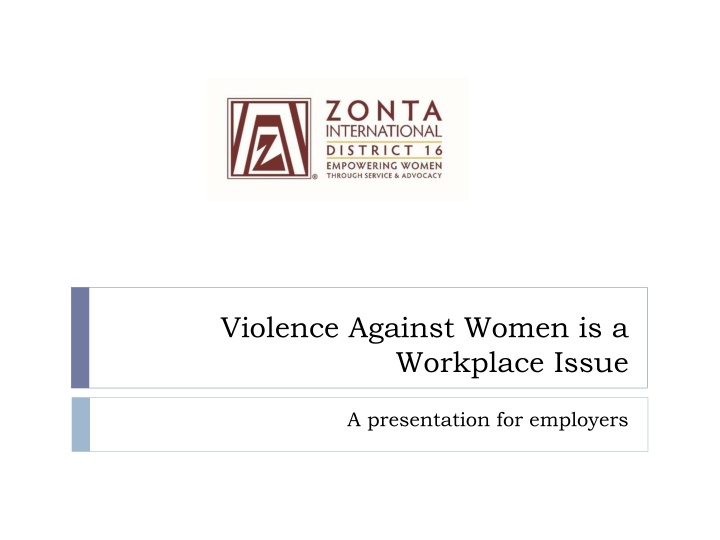

![Workplace Violence Prevention Plan in [District]: Definitions, Elements, and Implementation](/thumb/117038/workplace-violence-prevention-plan-in-district-definitions-elements-and-implementation.jpg)

